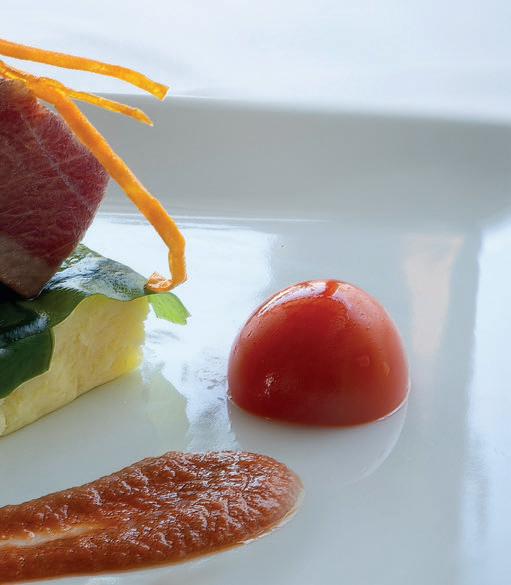
4 minute read
Qué comemos en Zahara / what to eat in Zahara
GASTRONOMY
What to eat in Zahara
Advertisement
Zahara has a wide, top-quality gastronomic offer. More and more restaurants strive to offer the best of our land combined with an excellent taste, a mixture of flavours that are not easily forgotten. There are many typical dishes, such as atún encebollado (tuna with onions), tortilla de camarones (shrimp omelette), fried and salted fish, and meats, as well as locally-grown fruit and vegetables, and regional wines, without forgetting, of course, our delicious homemade desserts and cakes.
But our star product is tuna fish. Nobody leaves Zahara without tasting it. But, you’ll be wondering, “What’s special about Zahara tuna fish?” Very simple, Zahara tuna is bluefin tuna, Thunnus thynnus, the largest of its species and considered one of the most evolved living in the oceans today, sometimes weighing more than 400 kg. It is a migratory species that travels great distances for feeding and reproductive purposes, supporting great changes in temperature and long distances of up to 100 km a day. Its strength and hydrodynamic body, makes it one of the fastest fish.
Elsewhere you can also eat tuna but the way of fishing it is very important. At Zahara it is caught using the Almadraba (trap set harvesting) technique, between the months of june and july. Almadraba (in Arabic meaning “place where to hit”) is an artisanal, selective, sustainable, and traditional fishing method, more than 3,000 years old, created by the Phoenicians, developed by the Romans and Arabs, until today. It consists of a maze of nets being placed near the coast, where the tuna fish are caught on their annual migration route from the North Atlantic on their way through the Strait of Gibraltar into the Mediterranean. Its meat is tasty, juicy, with an intense and authentic flavour that will delight your palate. It is called the “Ibérico of the sea” as every part is used. It is possible to eat it in many different ways: stewed, grilled, stuffed, with onions, salted, as dried salted tuna loin in oil, roe, dry, in lard or canned.
The Tuna Gastronomic Route is held in May (more information at http://rutadelatun.com/) where flavours and colours are combined with much imagination. Don’t miss it!
Another local delicacy is Retinto red veal from one of the purest cattle breeds in Spain with its certificate of origin. Tattle can be seen grazing in the fields around Zahara and near the beaches. In September, the Retinto Gastronomic Route is held (http://rutadelretinto.com/), with races on the beach, polo and a livestock show.

Qué comemos en Zahara
Zahara cuenta con una gran oferta gastronómica y de muy alta calidad. Cada vez más restaurantes se esfuerzan por ofrecer lo mejor de nuestra tierra combinado con un excelente gusto, una mezcla de sabores que no se olvidan fácilmente. Platos típicos hay muchos, atún encebollado, tortilla de camarones, pescado frito, a la sal y carnes, todo ello acompañado con las frutas y verduras de nuestros campos, y un buen vino de la tierra, sin olvidar por supuesto los deliciosos postres y dulces caseros.
Pero nuestro producto estrella es el atún. Nadie se va de Zahara sin probarlo, pero os preguntaréis ¿qué tiene de especial el atún en Zahara? Muy sencillo, el atún de Zahara es atún rojo, Thunnus thynnus, es el mayor de su especie y considerado uno de los más evolucionados y grandes que habitan en los océanos, pudiendo superar los 400 kg. de peso. Es una especie migratoria, que realiza grandes viajes con fines alimentarios y reproductivos, soportando grandes cambios de temperatura y largos recorridos de hasta 100 km. diarios. Su fuerza e hidrodinámico cuerpo, hace que sea uno de los peces más veloces.
En otros lugares también se puede comer atún pero la forma de capturarlo tiene mucha importancia. En Zahara aun hoy se captura mediante Almadraba, entre los meses de mayo a junio. La Almadraba (en árabe, lugar donde se lucha) es un arte de pesca artesanal, selectivo, sostenible, y tradicional, con más de 3.000 años de antigüedad, creado por los fenicios, desarrollado por los romanos y árabes, hasta hoy en día. Es un laberinto de redes dispuestas cerca de las costas, en donde quedan atrapados los atunes en su ruta migratoria anual desde el Norte Atlántico, en su paso por el estrecho de Gibraltar, hacia el Mediterráneo.
Su carne es sabrosa, jugosa, con un sabor intenso y auténtico que agradecerá nuestro paladar. Es llamado el ibérico del mar, ya que se aprovecha todo. Es posible tomar un plato preparado de diversas formas, ya sea guisado, a la plancha, mechado, encebollado, en salazón, mojama ijada en aceite, huevas, seco, en manteca o en conserva. En mayo se realiza una ruta gastronómica del atún (más información en http://rutadelatun.com/) donde combinan sabores, colores y mucha imaginación. ¡No os lo perdáis!
Otro manjar es el Retinto, una ternera roja catalogada como una de las razas vacunas más puras de España con certificado de origen y que se pueden ver por los campos por los alrededores de Zahara y hasta en las playas. En septiembre hay otra ruta gastronómica del Retinto (http://rutadelretinto.com/), amenizada con carreras en la playa, polo y muestra ganadera.








